#Ad-Hoc Orchestra
Explore tagged Tumblr posts
Text
So, I have a list of Eurovision songs from 2004 onwards ranking which entries did the best based on average score.
This year's Loreen, Käärijä, Noa Kirel and Marco Mengoni all made the list
1. Norway - 2009 - Alexander Rybak - Fairytale - 78.6%
2. Sweden - 2015 - Måns Zelmerlöw - Heroes - 77.9%
3. Portugal - 2017 - Salvador Sobral - Amar pelos dois - 77%
4. Sweden - 2012 - Loreen - Euphoria - 75.6%
5. Ukraine - 2022 - Kalush Orchestra - Stefania - 67.4%
6. Austria - 2014 - Conchita Wurst - Rise Like a Phoenix - 67.1%
7. Ukraine - 2004 - Ruslana - Wild Dances - 66.6%
8. Sweden – 2023 – Loreen – Tattoo – 66.5%
youtube
9. Finland - 2006 - Lordi - Hard Rock Hallelujah - 65.7%
10. Russia - 2015 - Polina Gagarina - A Million Voices - 64.7%
11. Serbia and Montenegro - 2004 - Željko Joksimović and Ad-Hoc Orchestra - Lane Moje - 62.6%
12. Bulgaria - 2017 - Kristian Kostov - Beautiful Mess - 62.5%
13. Italy - 2015 - Il Volo - Grande amore - 62.3%
14. Denmark - 2013 - Emmelie de Forest - Only Teradrops - 61.6%
15. Finland – 2023 – Käärijä – Cha Cha Cha – 60%
youtube
16. Greece - 2004 - Sakis Rouvas - Shake It - 60%
17. Italy - 2021 - Måneskin - Zitti e Buoni - 57.4%
18. Russia - 2006 - Dima Bilan - Never Let You Go - 55.8%
19. Netherlands - 2014 - The Common Linnets - Calm After the Storm - 55%
20. France - 2021 - Barbara Pravi - Voilà - 54.7%
21. Serbia - 2007 - Marija Šerifović - Molitva - 54.4%
22. Ukraine - 2016 - Jamala - 1944 - 54.2%
23. Russia - 2008 - Dima Bilan - Believe - 53.9%
24. Germany - 2010 - Lena - Satellite - 53.9%
25. Russia - 2012 - Buranovskiye Babushki - Party for Everybody - 52.6%
26. Israel - 2018 - Netta - Toy - 52.4%
27. Australia - 2016 - Dami Im - Sound of Silence - 51.9%
28. Netherlands - 2019 - Duncan Laurence - Arcade - 51.8%
29. Bosnia and Herzegovina - 2006 - Hari Mata Hari - Lejla - 51.5%
30. Azerbaijan - 2013 - Farid Mammadov - Hold Me - 51.3%
31. Greece - 2005 - Helena Paparizou - My Number One - 50.4%
32. Sweden - 2014 - Sanna Nielsen - Undo - 50.4%
33. Russia - 2016 - Sergey Lazarev - You Are the Only One - 49.8%
34. United Kingdom - 2022 - Sam Ryder - Space Man - 49.7%
35. Italy - 2019 - Mahmood - Soldi - 49.1%
36. Spain - 2022 - Chanel - SloMo - 49%
37. Azerbaijan - 2011 - Ell and Nikki - Running Scared - 48.4%
38. Ukraine - 2007 - Verka Serduchka - Dancing Lasha Tumbai - 47.7%
39. Switzerland - 2021 - Gjon's Tears - Tout l'univers - 47.3%
40. Ukraine - 2013 - Zlata Ognevich - Gravity - 46.9%
41. Sweden - 2022 - Cornelia Jakobs - Hold Me Closer - 46.7%
42. Turkey - 2004 - Athena - For Real - 46.4%
43. Belgium - 2015 - Loïc Nottet - Rhythm Inside - 46.3%
44. Ukraine - 2008 - Ani Lorak - Shady Lady - 45.6%
45. Iceland - 2009 - Yohanna - Is It True? - 44.3%
46. Serbia - 2012 - Željko Joksimović - Nije ljubav stvar - 43.4%
47. Cyprus - 2018 - Eleni Foureira - Fuego - 43.2%
48. Greece - 2008 - Kalomira - Secret Combination - 43.2%
49. Malta - 2005 - Chiara - Angel - 42.1%
50. Russia - 2007 - Serebro - Song #1 - 42%
51. Azerbaijan - 2009 - AySel and Arash - Always - 42%
52. Norway - 2013 - Margaret Berger - I Feed You My Love - 41.8%
53. Australia - 2015 - Guy Sebastian - Tonight Again - 41.8%
54. Italy - 2011 - Raphael Gualazzi - Madness of Love - 41.4%
55. Iceland - 2021 - Daði og Gagnamagnið - 10 Years - 41.4%
56. Israel – 2023 – Noa Kirel – Unicorn – 41.3%
youtube
57. Sweden - 2011 - Eric Saade - Popular - 40.5%
58. Cyprus - 2004 - Lisa Andreas - Stronger Every Minute - 40.4%
59. Sweden - 2004 - Lena Philipsson - It Hurts - 40.4%
60. Armenia - 2014 - Aram Mp3 - Not Alone - 40.3%
61. Italy – 2023 – Marco Mengoni – Due vite – 39.9%
youtube
62. Ukraine - 2021 - Go_A - Shum - 39.9%
63. Latvia - 2015 - Aminata - Love Injected - 39.7%
64. Armenia - 2008 - Sirusho - Qélé, Qélé - 39.4%
65. Romania - 2006 - Mihai Trăistariu - Tornerò - 38.7%
66. Russia - 2019 - Sergey Lazarev - Scream - 38.5%
67. Sweden - 2006 - Carola - Invincible - 38.2%
68. Russia - 2013 - Dina Garipova - What If - 38.1%
69. Moldova - 2017 - SunStroke Project - Hey Mamma - 38%
70. Switzerland - 2019 - Luca Hänni - She Got Me - 37.9%
71. Turkey - 2010 - Manga - We Could Be the Same - 37.2%
72. Belgium - 2017 - Blanche - City Lights - 36.8%
73. Lithuania - 2006 - LT United - We Are the Winners - 36.4%
74. Norway - 2008 - Maria - Hold On Be Strong - 36.1%
75. Turkey - 2009 - Hadise - Düm Tek Tek - 35.9%
76. Romania - 2010 - Paula Seling and Ovi - Playing with Fire - 35.5%
77. United Kingdom - 2009 - Jade Ewen - It's My Time - 35.1%
78. Sweden - 2017 - Robin Bengtsson - I Can't Go On - 34.9%
79. Ukraine - 2011 - Mika Newton - Angel - 34.8%
80. Sweden - 2019 - John Lundvik - Too Late for Love - 34.7%
81. Romania - 2005 - Luminița Anghel and Sistem - Let Me Try - 34.6%
82. Norway - 2019 - Keiino - Spirit in the Sky - 34.4%
83. Austria - 2018 - Cesár Sampson - Nobody but You - 33.9%
84. Italy - 2017 - Francesco Gabbanni - Occidentali's Karma - 33.9%
85. Germany - 2018 - Michael Schulte - You Let Me Walk Alone - 33.7%
86. Israel - 2005 - Shiri Maimon - HaSheket SheNish'ar - 33.7%
87. Latvia - 2005 - Walters and Khaza - The War Is Not Over - 33.5%
88. Serbia - 2022 - Konstrakta - In corpore sano - 33.3%
89. Greece - 2013 - Koza Mostra feat. Agathon Iakovidis - Alcohol Is Free - 33.3%
90. Turkey - 2007 - Kenan Doğulu - Shake It Up Şekerim - 33.1%
91. Hungary - 2014 - András Kállay-Saunders - Running - 33.1%
92. Finland - 2021 - Blind Channel - Dark Side - 33%
93. Denmark - 2010 - Chanée and N'evergreen - In a Moment like This - 32.6%
94. Ukraine - 2006 - Tina Karol - Show Me Your Love - 32.6%
95. Moldova - 2005 - Zdob și Zdub - Boonika bate toba - 32.4%
96. Bulgaria - 2007 - Elitsa Todorova and Stoyan Yankoulov - Water - 31.7%
97. Azerbaijan - 2010 - Safura - Drip Drop - 31.7%
98. Serbia - 2008 - Jelena Tomašević feat. Bora Dugić - Oro - 31.7%
99. North Macedonia - 2019 - Tamara Todevska - Proud - 31.7%
100. Azerbaijan - 2019 - Chingiz - Truth - 31.4%
Full YouTube playlist
Semi Full Spotify Playlist because some songs are just not on Spotify 😭😔😞
#Eurovision#Eurovision 2023#Loreen#Käärijä#Noa Kirel#Marco Mengoni#Sweden#Finland#Israel#Italy#Alexander Rybak#Måns Zelmerlöw#Salvador Sobral#Kalush Orchestra#Conchita Wurst#Ruslana#Lordi#Polina Gagarina#Željko Joksimović#Ad-Hoc Orchestra#Kristian Kostov#Il Volo#Emmelie de Forest#Sakis Rouvas#Måneskin#Dima Bilan#The Common Linnets#Barbara Pravi#Marija Šerifović#Jamala
9 notes
·
View notes
Text
Željko Joksimović
I figured I would use this post to rank the list of songs by the iconic Eurovision performer, songwriter, and host Željko Joksimović.
He made history as the first host of the contest to have a song he wrote in the contest (that being 2008 with the song being for host country Serbia). For this ranking, while he does have songs that went through National Finals, but didn't win, I will only be counting the five that went to Eurovision!
Montenegro 2015 ("Adio" by Knez)
Bosnia & Herzegovina 2006 ("Leijla" by Hari Mata Hari)
Serbia 2012 ("Nije ljubav stvar" by himself)
Serbia 2008 ("Oro" by Jelena Tomašević feat. Bora Dugić)
Serbia & Montenegro 2004 ("Lane moje" by himself & Ad-Hoc Orchestra)
Again, this set of songs are quite actually awesome as these songs are amazing ballads that will transcend time.
1 note
·
View note
Text
Eurovision 2004: The Scoreboards

For some reason, I've neglected to mention that, for the past two years, each host has selected a slogan or theme for that year's Eurovision. In Tallin it was A Modern Fairytale, in Riga it was Magical Rendez-vous. This year, TRT have gone with Under the Same Sky which given the location of Istanbul, the city that's in both Europe and Asia makes a whole heap of sense.
That theme is reflected in the layout of the scoreboard. Two arcs of nations either side of the spokesperson delivering the results. Albeit with the implication that the European half of the results are a much, much better than the Asian side.
Another first is that the flags of the countries are present inside heart-shaped cut outs. That heart is going to become ubiquitous. It's used all over the place this year and will be back in the future.
Now there's a semi, there's more than one scoreboard. More for the graphic design department to do - although not too much more. The scores aren't given at the end of the semi, only a list of the winners. That's a relatively simple task.
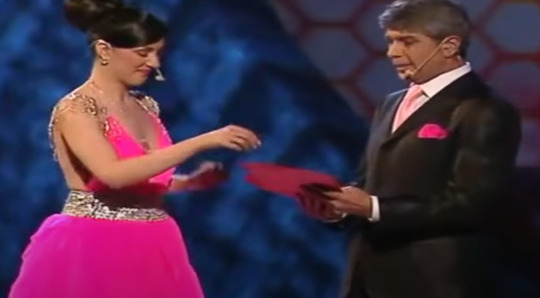
The results reveal for the semi final is done in a very traditional manner with the hosts picking from a set of red envelopes at random to reveal each of the qualifiers. It should be tense, yet somehow it's not quite there yet. Work to do.
Time for the spoilers.
The ten qualifying countries were (in order of the number of points they received):
Serbia & Montenegro - 263 points
Ukraine - 256 points
Greece - 238 points
Albania - 167 points
Cyprus - 149 points
Netherlands - 146 points
Bosnia & Herzegovina - 133 points
Malta - 74 points
Croatia - 72 points
North Macedonia - 71 points
There was quite a big drop down to Israel in 11th place who had 57 points. These scores were only released after the grand final.
Those ten countries joined the 14 other pre-qualified countries in the grand final. There was a lot less tension in the scoring this year. Two countries jostled for the lead for most of the sequences, but in the end Ukraine pulled clear with a few countries still to go. Slovenia this time were the third last voters and it was once again joker Peter Poles delivering the points that cemented the winner. With two countries to go, Ukraine couldn't be beaten - even though they were the final country to vote.
At the bottom end of the scoreboard, there were no nul points this year, but there weren't many points in total at all. The seven bottom countries all got fewer than 20 points. There was chasm between the top 6 and everyone else.
The grand final full results were:
Ukraine - Ruslana - "Wild Dances" - 280 points
Serbia & Montenegro - Željko Joksimović and Ad-Hoc Orchestra - "Lane moje" - 263 points
Greece - Sakis Rouvas - "Shake It" - 252 points
Türkiye - Athena - "For Real" - 195 points
Cyprus - Lisa Andreas - "Stronger Every Minutes" - 170 points
Sweden - Lena Philipsson - "It Hurts" - 170 points (joint 5th)
Albania - Anjeza Shahini - "The Image of You" - 106 points
Germany - Max - "Can't Wait Until Tonight" - 93 points
Bosnia & Herzegovina - Deen - "In the Disco" - 91 points
Spain - Ramón - "Para llenarme de ti" - 87 points
Russia - Julia Savicheva - "Believe Me" - 67 points
Malta - Julie and Ludwig - "On Again... Off Again" - 50 points
Croatia - Ivan Mikulić - "You Are the Only One" - 50 points (joint 12th)
North Macedonia - Toše Proeski - "Life" - 47 points
France - Jonatan Cerrada - "À chaque pas" - 40 points
United Kingdom - James Fox - "Hold On to Our Love" - 29 points
Poland - Blue Café - "Love Song" - 27 points
Romania - Sanda - "I Admit" - 18 points
Iceland - Jónsi - "Heaven" - 16 points
Netherlands - Re-union - "Without You" - 11 points
Austria - Tie Break - "Du bist" - 9 points
Belgium - Xandee - "1 Life" - 7 points
Ireland - Chris Doran - "If My World Stopped Turning" - 7 points (joint 22nd)
Norway - Knut Anders Sørum - "High" - 3 points
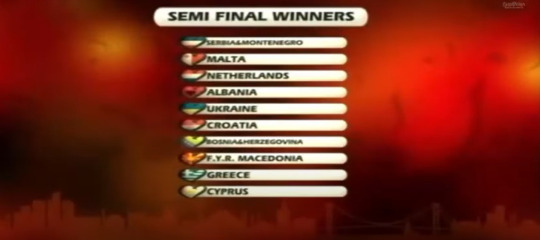
1 note
·
View note
Link
0 notes
Text
Poor Things, (2023) Yorgos Lanthimos
I saw this in the theater recently and was moved. It’s initially confusing to figure out what this “movement” consists in. The film is packed with psychedelic colors, upsetting events, and sexual scenes; it's quite stimulating. So I’d like to tease out what went on in my mind and heart, whose rustlings were soft but painfully good.
Here are the basics of the plot. A crazy scientist, who sees science as the means for bringing about a more just future (a moral that is endorsed and that I appreciate, as a side-note), brings a new human into the world. Her name is Bella. She is enclosed in the body of a beautiful woman. We see Bella grow up, psychologically, from a newborn level of babbling and lack of motor control. We witness her discover sexual pleasure and become obsessed with engaging in sexual activity as much as possible, until she discovers reading, whose stimulation attracts her just as much, which is something to which we’ve become numb. We see her first moment of understanding the injustice on which her life is based and her horror, which is also something to which we’ve become numb. We see men fall in love with her, become envious of her love for living, or desire to destroy her.
The film evoked in me a memory. When I was 15, I woke up from a numbness that had been going on for many years. I experienced, for what felt like the first time, what it was like to be able to go on a walk—to see the beauty of the sky, feel the satisfaction of breathing, and delight in the energy coursing through my body. I experienced what it was like to talk to another human and to enter the amazement of how we make possible in each other new ideas and delight, out from thin air. I imagined all of the activities I couldn’t wait to experience "for the first time," once I got home: bicycling, painting, and so on.
Since then, there've been some moments that involve "waking up. They aren't as totalizing as this first awakening, but they are made possible by their pooling into the grooves of this first awakening, imprinted upon my mind. The most recent one I remember happened a few months ago. I was stunned by the beauty of words with which I’ve been transacting all along in my research: "emotion," "the unconscious," "experience." Their abstraction was vivid and beautiful like music. It was as if each word were its own orchestra, playing melodies I can barely hear through the obfuscation of the finitude of my mind, but which I know is out there.
Here's a way I’ve made sense of these awakenings: It’s a silver lining of having lived under a stretch of numbness over my childhood. Today, I get to experience things for the first time with the body and mind of an adult, capable of making sense of and valuing these things in light of humanity and history. The “first times,” for most people, occurred in childhood, where cognizing things, like the acts of walking and friendship, in as penetrating of a way, simply isn’t accessible. Maybe this is an ad-hoc rationalization of a life narrative. Or maybe there’s truth here. I’ve been told that it’s astonishing how much energy I have, or ridiculous how enthusiastic I can get over random things. This way of being, which I can't help, is a trajectory that was set by that first awakening at age 15.
Bella’s situation is somewhat analogous to this. Since she’s growing up in an adult’s body, people have feelings and thoughts towards her as if she were any adult. This provides circumstances for her to grow, which are impossible for normal adults (with adult, not infant, minds), as much as for normal infants (with infant, not adult, bodies.) She registers adult events (e.g., being the object of infatuation for other men; hearing philosophical ideas that can change how everything seems; learning about slavery) from the place of full-force curiosity of an infant.
This readily provides a contrast to how most of us inhabit the world. We assume that what will happen is familiar, so we do not notice much in what happens and aren’t changed. We feel stifled in our lives, by the everyday rhythm of anticipatable dissatisfactions and satisfactions.
In contrast, when Bella looks at the same occurrence as we do, she reaches for more. She doesn’t demand for more, in the sense of self-entitlement. Rather, she simply takes as a fact of reality that there is more, and that her world shall be overturned by meeting it. This theme of renewal through living is echoed in the fact that Bella’s body is her mother’s, and her mind belongs to the baby with whom her mother was pregnant. She is both mother and daughter. We see Bella curious to find out more about who her mother was, this person whose body is hers, and to whom she owes her life. I love this as a dramatic metaphor for renewal in any of our lives. Our pasts may become as distant and different from who we are now, as Bella’s mother is to Bella. Transformation can happen to a life. Moreover, this is not an insular process. Our motherhood of our future selves depends upon the love and intimacy we have with each other.
I thought that Bella stands as an “antidote” to the sort of depression and anxiety with which the alarmingly increasing proportion of people in the U.S. get diagnosed. While one can't just choose to be like Bella, perhaps one can begin to enter places of meaningfulness like hers by assuming that one knows nothing, while practicing the bottom line of trusting and being kind to others.
I haven’t explored any “morals” that are unusual or complex here. I get the sense that this film is simple in this way. But its simple ideas are important ones, and the delivery is fun and engaging.
0 notes
Text
A meadow for Autumn
Forest, I lay me down to rest upon bed of moss.
Eternal sleep immediately overtakes me lichen kenning myself as Rip Van Winkle except being repurposed as oldest living species.
With an estimated age of 8,600 years,
Rhizocarpon geographicum,
also referred to as the Map lichen,
is the planet's oldest lichen.
Said complex life forms witness symbiotic partnership
of two separate organisms,
a fungus and an alga to equinoctial metaphor
at which the sun crosses the celestial equator,
when day and night
approximately equal length
(about September 22 and March 20).
When evening doth fall
'pon summers’ end,
a hint of splendor
bequeathed arose firmament changed scenery
(this soon third equinox act
since new year) bellows basses loaded and blasted
in sync with
pyrotechnic pizzazz,
while electric light orchestras
suites scored for cellos, thus quiet riot madrigal
of multitudinous notes swirl
from bronzed leaf like fellows dancing elliptically forsooth
greeting mother earth
with characteristic rills brawny sons and daughters
harvest September hellos before dawn's early light mellows.
Against backdrop sensational war
doth mother nature wage, how peachy keen, and grand to be seated
at plum lined tree center stage to behold colorful capering downward spiraling threnody quintessential silent rage chapter three nature alluded to
a tome poem, and first page
known to humans since…
way before indigenous tribes occupied North America
such as Osage and/or other natives,
whose keen scents foretold
the onset from flora and fauna sings they did gauge.
Now the regimentation
of existence commandeered by strict adherence affianced to the clock lest an employee arrive one second late –
her/his pay will go hickory dock which sequestration
to the twenty first century life analogous to men undergoing emasculation,
whereby he may as well be a eunuch without thick horn, where business
deals concluded as overhead
a flock of seagulls
migrate to southern climes,
which with global warming seems ad hoc
yet the multitudinous animals and plants
genetically under rubric of lifelock, which mucking around viz industrialization
humankind doth make a mock
‘ere re: and drive many miniscule species
to take safety and shelter under a rock
totally oblivious,
those bipedal hominids haphazardly scurry to work in order
to purchase schlock courtesy crypto currency redeemable at social media platforms especially one named TikTok.
Thus this pre dormant season,
where one must be vigilant and tread like angels heeding curtain call
draw wing summer to a close with damn the torpedoes salvo,
the cacophony kaleidoscope of color per fifty plus shades of red forecast thee onset
of cooler temperatures
with falun gong foliage natural compost
shelter burrowing creatures,
who stash goodies
at a later time to be fed thus each of us need be vigilant
with no misstep to tread upon feet lightly negotiating
whereat dwells busy itty-bitty bodies
well nigh invisible to the naked eye,
yet if ground swell of organisms once would behold
a micro/macroscopic
whirled wide web.
0 notes
Text
L’Estate in Musica 2023 del Teatro Massimo di Palermo
Il Teatro Massimo di Palermo fino a settembre proporrà una stagione estiva davvero da non perdere, grazie a un ricco programma di appuntamenti diffusi tra il Teatro di Verdura, il teatro di Piazza Verdi, il Chiostro della biblioteca comunale Leonardo Sciascia e la fattoria di Danisinni. Per la prima volta a Palermo, il 20 e il 21 luglio alle 21.15 ci sarà Zorba il greco, balletto di grande successo, creato dal coreografo Lorca Massine sulla musica di Mikis Theodorakis, composta per il film del 1965, interpretato da Anthony Quinn e Irene Papas, e adattata per il balletto dallo stesso compositore, che racconta la storia di amicizia fra Zorba il greco e il turista americano John. A interpretarlo è il Corpo di Ballo del Teatro Massimo insieme a Dan Haja, solista ospite e prima ballerina del Teatro dell’Opera di Cluj, insieme all’Orchestra e al Coro del Teatro Massimo diretti da Danila Grassi. Contralto Myrtò Bocolini. Maestro del Coro Salvatore Punturo. Direttore del Corpo di ballo Jean-Sébastien Colau. Si prosegue il 23 luglio con Tribute to Burt Bacharach, che rinnova la collaborazione tra l’Orchestra Jazz Siciliana-The Brass Group e l’Orchestra del Teatro Massimo, un omaggio al compositore americano recentemente scomparso sotto la direzione del maestro Domenico Riina. La voce è di Lucy Garsia, all’armonica Giuseppe Milici. Ed è sempre la danza ad essere protagonista il 29 luglio al Teatro di Verdura, con il Gala Wellber & Dance con il Corpo di Ballo del Massimo insieme alle étoiles ospiti Silvia Saint-Martin e Francesco Mura, primi ballerini dell’Opera di Parigi ed ospite della serata è Jacob Reuven, uno dei più apprezzati virtuosi di mandolino. L’ultimo appuntamento al Verdura è il 2 agosto, alle 21.15, con Young in green, un concerto che nasce dall’ accordo di collaborazione siglato dai sovrintendenti Marco Betta per la Fondazione Teatro Massimo e Michele dall’Ongaro per l’Accademia Nazionale di Santa Cecilia. Dal 2 al 13 luglio alle 21:15 è il Chiostro della biblioteca comunale ad ospitare Diari di viaggio, tre concerti che impegnano l’Orchestra del Teatro, guidata per l’occasione da tre direttori di diversa estrazione musicale e provenienza geografica. Il 7 luglio alle 21.15 ci sarà alla Fattoria di Danisinni, Short Opera-La traviata, l’opera musicale con cui la Fondazione Teatro Massimo prosegue il lavoro avviato in alcuni dei quartieri della città con OperaCity Danisinni e Istant Opera Noi Sperone, ideato e diretto dal regista Marco Canzoneri, arricchito dalle immagini video di Gianluigi Toccafondo e dalla scenografia creata ad hoc da Stefano Canzoneri In parallelo con gli appuntamenti al Teatro di Verdura, alla biblioteca comunale e alla Fattoria di Danisinni, si sviluppa un ricco calendario anche in Teatro, dalla Sala grande al Foyer alla Sala pompeiana che ospita contemporaneamente la mostra di opere di Elisabeth Scherffig che illustrano i manifesti della stagione 2022/23 del Teatro. Il 20, 21 e 23 giugno, alle 20.30 nel Foyer del Teatro per Musica del tempo che verrà saranno presentate le composizioni commissionate dal Teatro Massimo ai tre compositori siciliani Giovanni Di Giandomenico, che presenta L’educazione del vento, per piccola orchestra e coro maschile; Alberto Maniaci autore di In nomine Matris, cinque storie per coro e orchestra; e Giuseppe Ricotta con The Creation suite, per coro femminile e orchestra. Invece il 22 giugno alle 20:30 debutta in Sala Grande "L’altro", l'opera corale, scritta e diretta da Gery Palazzotto. per raccontare, a seconda dei punti di vista, la memoria che si cela nell’attualità e la realtà che tende a oscurare il ricordo. Tornano il 5, il 12, il 13, e il 30 luglio, alle 19, in Sala Grande, gli Immersive concert, un format di successo che propone pagine celebri del repertorio operistico italiano, da Rossini a Verdi a Bellini per riscoprire l’acustica perfetta e la bellezza di uno dei teatri storici più grandi d’Europa. Il 9 luglio alle 20.30 saranno i Carmina Burana di Carl Orff a suonate nella Sala grande del Teatro nell’inconsueta versione per due pianoforti e percussioni con il Coro e i percussionisti dell’Orchestra del Teatro Massimo diretti da Salvatore Punturo.. Quattro concerti per arpa saranno eseguiti il 15, il 16, il 22 e il 23 luglio alle 19.00 in Sala Pompeiana, che ospiterà fino a novembre la mostra delle opere di Elisabeth Scherffig, l’artista tedesca a cui, in collaborazione con la Fondazione Palazzo Butera, il Massimo ha affidato la creazione dell’immagine grafica della stagione 2022/23. Il 19 luglio, alle 20:30, Kids Journey, in Sala Grande, sarà un altro viaggio musicale tra le note di Georges Bizet, Bruno Coulais, Alberto Maniaci, Ennio Morricone, Salvatore Nogara, Gerald Oswald con la Massimo Youth Orchestra e il Coro di voci bianche. Infine il 25 luglio, alle 20.30 in Foyer , saranno le giovani voci della Cantoria dirette da Giuseppe Ricotta a intonare le musiche di Johannes Brahms, Antonio Fortunato, Giuseppe Ricotta, David Lang, Ola Gjello, Nunzio Ortolano, Moses Hogan, Huddie Ledbetter insieme al Quintetto d’archi della Massimo Youth Orchestra e, dal 28 luglio al 4 agosto, per Piano Young si esibiranno in Foyer alle 20:30 i pianisti della Massimo Youth Orchestra Enrico Gargano, Claire Monteleone, Riccardo Di Giovanni e Vittoria D’Agostaro. Read the full article
0 notes
Photo

CdA: "GLI OCCHI DEI GIGANTI" è IL SINGOLO NUOVO
Dal 5 maggio 2023 è disponibile in rotazione radiofonica e su tutte le piattaforme di streaming digitale "Gli Occhi dei Giganti", il nuovo singolo dei CdA.
"Gli Occhi dei Giganti" è un brano che racconta di come le persone che appaiono più spaventose o imponenti, come i giganti, possono nascondere un cuore gentile o una storia difficile che le ha rese così. Il pezzo invita l'ascoltatore a non farsi intimorire dalle apparenze e a prendersi il tempo di conoscere davvero le persone.
Spiega la band a proposito del brano: «Il brano racconta la storia di una persona che cerca di fuggire dal proprio passato, ma si rende conto che la chiave per liberarsi è dentro di sé.
Il brano è caratterizzato da un sound intenso e coinvolgente, accompagnato da un testo che emoziona e fa riflettere. La melodia si sviluppa in modo graduale, creando una tensione che si risolve solo nel ritornello.
Le parole del ritornello, "Non correre / anche gli occhi dei giganti hanno lacrime / chiuse in un diario e poi strappato / in mille pagine", sono un invito a non fuggire dalle proprie emozioni e dal proprio passato, ma a riconoscere e accettare le proprie fragilità e a non scappare dalle proprie paure, ma ad affrontarle con coraggio. È stato prodotto con cura e attenzione ai dettagli, con un arrangiamento rock accompagnato anche dall'orchestra "player 2 Orchestra"».
Guarda il lyric video su YouTube: https://www.youtube.com/watch?v=O62p9GVjXM4
Biografia
"CdA" nascono a Roma nel 2014 con l'obiettivo di portare sui palchi di tutta Italia le sigle dei cartoni animati più amati trasmessi dagli anni '70 fino ad oggi. Grazie ai loro elettrizzanti arrangiamenti in chiave Rock e a un vero e proprio Show completo di sketch e video proiezioni ad hoc, riescono a divertire, appassionare e far rivivere emozioni sopite dal tempo.
L'effetto nostalgia che attivano i CdA quando salgono sul palco fa venir voglia di scoprire, sigla dopo sigla, quale sarà il prossimo ricordo ad uscire dal cassetto. Dal 2022 affiancano a quello delle cover un nuovo percorso che li porta a scrivere brani inediti inerenti il mondo degli anime giapponesi. I primi singoli "Con un pugno" (One Punch Man) e "You & I" (Demon Slayer) sono disponibili in tutti gli store e le piattaforme digitali. Dopo quasi dieci anni di attività, i CdA vantano collaborazioni con molti doppiatori e artisti del campo musicale e dell'animazione, nonché l'essersi esibiti in numerosi locali prestigiosi e l'aver calcato i più famosi palchi italiani. Apparizioni in articoli di giornale, rubriche radiofoniche e trasmissioni televisive completano il curriculum vitae di questa band di ragazzi romani pronti a portare a termine la loro missione alla fine di ogni concerto: far divertire ed emozionare fino all'ultimo spettatore.
"Gli Occhi dei Giganti" è il nuovo singolo dei CdA disponibile sulle piattaforme digitali di streaming e in rotazione radiofonica da venerdì 5 maggio 2023.
https://www.instagram.com/cdaband_official/
0 notes
Video
youtube
Nothing is more revealing than the composer's own description of his work, and so is the case of Michael Daugherty: “Dead Elvis (1993) was commissioned by Boston Musica Viva and Chuck Ullery, principal bassoonist with the St. Paul Chamber Orchestra. It is more than a coincidence that it is scored for the same instrumentation as Stravinsky's L'Histoire du Soldat (1918) in which a soldier sells his violin and his soul to the devil for a magic book. In Dead Elvis, the bassoon is Elvis (or perhaps an Elvis impersonator). Does this rock star sell out his Southern folk authenticity to the sophisticated professionalism of Hollywood movies, Colonel Parker and Las Vegas in order to attain great wealth and fame? Dead Elvisgoes far beyond this romantic Faustian scenario. For me, the two clashing Elvis images (the hip, beautiful, genius, thin, rock-and-roll Elvis versus the vulgar, cheesy, fat, stoned, Las Vegas Elvis) serve as a Sturm und Drang compositional algorithm. Further, my use of the “dies irae” (a Medieval Latin chant for the Day of Judgment) as the principal musical theme of Dead Elvis signifies yet another aspect of the Elvis myth: some people believe Elvis is dead, while others believe he is alive and well in Kalamazoo. Perhaps the question is not whether Elvis is alive or dead, but why the phenomenon of Elvis endures beyond the grave of Graceland. Elvis, for better or worse, is part of American culture, history and mythology. If you want to understand America and all its riddles, sooner or later you will have to deal with (Dead) Elvis.” – Michael Daugherty
From Russian folklore to Faust and beyond, the tale of an every-man selling his soul to the Devil for riches and subsequently suffering eternal damnation remains one of humanity's greatest paradoxes – simultaneously a greatest wish and a most dreaded nightmare. Daugherty clearly states that Elvis fell prey to the Faustian trap, and as a consequence lost his artistic essence. But even more profane than questioning the infallibility of an American pop icon is another question: is Elvis America's Christ figure? As an exceptional boy raised by a single mother in poverty, he was propelled into stardom by embodying in a pelvis-swinging, dreamy white boy the soul of Negro songs. Elvis' meteoric career eventually sapped the young singer of his authenticity, leading to his inevitable fall from grace and into a dangerous cocktail of drugs, alcohol and debauchery. Forsaken by all but his most ardent fans, the destroyed singer's death is mysteriously unclear – and many continue to believe in his continued life beyond Graceland.
(Elisabeth Askren, source: ligetifestival.ro)
Gottfried Rabl - conductor Cristian Avram - bassoon Ensemble Ad-HOC ”and Friends”
Enjoy! 🎃 - Editor-in-Chief
#michael daugherty#michael#daugherty#michaeldaugherty#dead elvis#deadelvis#elvis#elvis presley#elvispresley#music#classicalmusic#bassoon#conductor#ensemble#friends#1993#musica#musicainextenso#musica in extenso#halloween#happyhalloween#america
11 notes
·
View notes
Text
Good evening Europe!
It's that magical time of the year again when we all come together to trash each others' musical tastes!
The point system has changed many times over the years, and as various countries have come and gone, it is hard to determine who did "the best" based on the points they got alone as, since the maximum available points doubled with the jury and televote scores no longer being combined, post 2016 entries would have an obvious advantage and, likewise, the contests with 40+ participants would also have more maximum available points to give so a country getting 200 points in 2004 is not the same as another getting 200 points in 2009 or 2016.
But if we divide the points each entry got by the maximum available points for the respective year it competed, we get a percentage score that can easily be measured against entries from years with differing point systems.
So, for example, in 2009 42 countries participated. The maximum points each country can award is of course 12 and you can't vote for yourself. So 41 × 12 = 492. Let's then take Norway's total of 387 points and divide it by the 492 total of maximum available points. We get 78.6, meaning Norway and Alexander Rybak amassed 78.6% of the total points in 2009!
In the case of tie breaks the entry that placed higher in its respective year wins the tie break and if there's still a tie I used rules similar to the actual contest; the winner of a tie is the entry that received more points from televoting. If there are no split results available to the public, the entry that received points from more countries, then the country that received more 12 points, then 10 points all the way down to 1. If the tie cannot be broken in this way, the entry that performed earlier wins the tie break.
I've set 2004 as the "beginning of time", if you will, because that's when I started watching Eurovision and because there also had to be some sort of limit to how far back I would go with this 🤣
With that very long-winded explanation of my measuring tactics out of the way, shall we see our current Top 100 before new entries are added after the 2023 Grand Final is over?
100. Greece 🇬🇷 - 2010 - Giorgos Alkaios and Friends - Opa - 30.7%
99. Armenia 🇦🇲 - 2010 - Eva Rivas - Apricot Stone - 30.9%
98. Bulgaria 🇧🇬 - 2016 - Poli Genova - If Love Was a Crime - 31.1%
97. Belgium 🇧🇪 - 2010 - Tom Dice - Me and My Guitar - 31.3%
96. Azerbaijan 🇦🇿 - 2019 - Chingiz - Truth - 31.4%
95. North Macedonia 🇲🇰 - 2019 - Tamara Todevska - Proud - 31.7%
94. Serbia 🇷🇸 - 2008 - Jelena Tomasevic feat. Bora Duguc - Oro - 31.7%
93. Azerbaijan 🇦🇿 - 2010 - Safura - Drip Drop - 31.7%
92. Bulgaria 🇧🇬 - 2007 - Elitsa Todorova and Stoyan Yankoulov - Water - 31.7%
91. Moldova 🇲🇩 - 2005 - Zdob si Zdub - Boonika bate toba - 32.4%
90. Ukraine 🇺🇦 - 2006 - Tina Karol - Show Me Your Love - 32.6%
89. Denmark 🇩🇰 - 2010 - Chanée and N'evergreen - In a Moment like This - 32.6%
88. Finland 🇫🇮 - 2021 - Blind Channel - Dark Side - 33%
87. Hungary 🇭🇺 - 2014 - András Kállay-Saunders - Running - 33.1%
86. Turkey 🇹🇷 - 2007 - Kenan Dogulu - Shake It Up Sekerim - 33.1%
85 Greece 🇬🇷 - 2013 - Koza Mostra feat. Agathon Iakovidis - Alcohol Is Free - 33.3%
84. Serbia 🇷🇸 - 2022 - Konstrakta - In corpore sano - 33.3%
83. Latvia 🇱🇻 - 2005 - Walters and Khaza - The War Is Not Over - 33.5%
82. Israel 🇮🇱 - 2005 - Shiri Maimon - HaSheket SheNish'ar - 33.7%
81. Germany 🇩🇪 - 2008 - Michael Schulte - You Let Me Walk Alone - 33.7%
80. Italy 🇮🇹 - 2017 - Francesco Gabbani - Occidentali's Karma - 33.9%
79. Austria 🇦🇹 - 2018 - Cesár Sampson - Nobody but You - 33.9%
78. Norway 🇳🇴 - 2019 - Keiino - Spirit in the Sky - 34.4%
77. Romania 🇷🇴 - 2007 - Luminita Anghel and Sistem - Let Me Try - 34.6%
76. Sweden 🇸🇪 - 2019 - John Lundvik - Too Late for Love - 34.7%
75. Ukraine 🇺🇦 - 2011 - Mika Newton - Angel - 34.8%
74. Sweden 🇸🇪 - 2017 - Robin Bengtsson - I Can't Go On - 34.9%
73. United Kingdom 🇬🇧 - 2009 - Jade Ewen - It's My Time - 35.1%
72. Romania 🇷🇴 - 2010 - Paula Seling and Ovi - Playing with Fire - 35.5%
71. Turkey 🇹🇷 - 2009 - Hadise - Düm Tek Tek - 35.9%
70. Norway 🇳🇴 - 2008 - Maria - Hold On Be Strong - 36.1%
69. Lithuania 🇱🇹 - 2006 - LT United - We Are the Winners - 36.4%
68. Belgium 🇧🇪 - 2017 - Blanche - City Lights - 36.8%
67. Turkey 🇹🇷 - 2010 - Manga - We Could Be the Same - 37.2%
66. Switzerland 🇨🇭 - 2019 - Luca Hänni - She Got Me - 37.9%
65. Moldova 🇲🇩 - 2017 - SunStroke Project - Hey Mamma - 38%
64. Russia 🇷🇺 - 2013 - Dina Garipova - What If - 38.1%
63. Sweden 🇸🇪 - 2006 - Carola - Invincible - 38.2%
62. Russia 🇷🇺 - 2019 - Sergey Lazarev - Scream - 38.5%
61. Romania 🇷🇴 - 2006 - Mihai Traistariu - Tornerò - 38.7%
60. Armenia 🇦🇲 - 2008 - Sirusho - Qélé, Qélé - 39.4%
59. Latvia 🇱🇻 - 2015 - Aminata - Love Injected - 39.7%
58. Ukraine 🇺🇦 - 2021 - Go_A - Shum - 39.9%
57. Armenia 🇦🇲 - 2014 - Aram Mp3 - Not Alone - 40.3%
56. Sweden 🇸🇪 - 2004 - Lena Philipsson - It Hurts - 40.4%
55. Cyprus 🇨🇾 - 2004 - Lisa Andreas - Stronger Every Minute - 40.4%
54. Sweden 🇸🇪 - 2011 - Eric Saade - Popular - 40.5%
53. Iceland 🇮🇸 - 2021 - Dathi og Gagnamagnith - 10 Years - 41.4%
52. Italy 🇮🇹 - 2011 - Raphael Gualazzi - Madness of Love - 41.4%
51. Australia 🇦🇺 - 2015 - Guy Sebastian - Tonight Again - 41.8%
50. Norway 🇳🇴 - 2013 - Margaret Berger - I Feed You My Love - 41.8%
49. Azerbaijan 🇦🇿 - 2009 - AySel and Arash - Always - 42%
48. Russia 🇷🇺 - 2007 - Serebro - Song #1 - 42%
47. Malta 🇲🇹 - 2005 - Chiara - Angel - 42.1%
46. Greece 🇬🇷 - 2008 - Kalomira - Secret Combination - 43.2%
45. Cyprus 🇨🇾 - 2018 - Eleni Foureira - Fuego - 43.2%
44. Serbia 🇷🇸 - 2012 - Zeljko Joksimovic - Nije ljubav stvar - 43.4%
43. Iceland 🇮🇸 - 2009 - Yohanna - Is It True? - 44.3%
42. Ukraine 🇺🇦 - 2008 - Ani Lorak - Shady Lady - 45.6%
41. Belgium 🇧🇪 - 2015 - Loïc Nottet - Rhythm Inside - 46.3%
40. Turkey 🇹🇷 - 2004 - Athena - For Real - 46.4%
39. Sweden 🇸🇪 - 2022 - Cornelia Jakobs - Hold Me Closer - 46.7%
38. Ukraine 🇺🇦 - 2013 - Zlata Ognevich - Gravity - 46.9%
37. Switzerland 🇨🇭 - 2021 - Gjon's Tears - Tout l'univers - 47.3%
36. Ukraine 🇺🇦 - 2007 - Verka Serduchka - Dancing Lasha Tumbai - 47.7%
35. Azerbaijan 🇦🇿 - 2011 - Ell and Nikki - Running Scared - 48.4%
34. Spain 🇪🇸 - 2022 - Chanel - SloMo - 49%
33. Italy 🇮🇹 - 2019 - Mahmood - Soldi - 49.1%
32. United Kingdom 🇬🇧 - 2022 - Sam Ryder - Space Man - 49.7%
31. Russia 🇷🇺 - 2016 Sergey Lazarev - You Are the Only One - 49.8%
30. Sweden 🇸🇪 - 2014 - Sanna Nielsen - Undo 50.4%
29. Greece 🇬🇷 - 2005 - Helena Paparizou - My Number One - 50.4%
28. Azerbaijan 🇦🇿 - 2013 - Farid Mammadov - Hold Me - 51.3%
27. Bosnia and Herzegovina 🇧🇦 - 2006 - Hari Mata Hari - Lejla - 51.5%
26. Netherlands 🇳🇱 - 2019 - Duncan Lawrence - Arcade - 51.8%
25. Australia 🇦🇺 - 2016 - Dami Im - Sound of Silence - 51.9%
24. Israel 🇮🇱 - 2018 - Netta - Toy - 52.4%
23. Russia ���🇺 - 2012 - Buranovskiye Babushki - Party for Everybody - 52.6%
22. Germany 🇩🇪 - 2010 - Lena - Satellite - 53.9%
21. Russia 🇷🇺 - 2008 - Dima Bilan - Believe - 53.9%
20. Ukraine 🇺🇦 - 2016 - Jamala - 1944 - 54.2%
19. Serbia 🇷🇸 - 2007 - Marija Serifovic - Molitva - 54.4%
18. France 🇫🇷 - 2021 - Barbara Pravi - Voilà - 54.7%
17. Netherlands 🇳🇱 - 2014 - The Common Linnets - Calm After the Storm - 55%
Honourable Mention. Turkey 🇹🇷 - 2003 - Sertab Erener - Everyway That I Can - 55.6%
16. Russia 🇷🇺 - 2006 - Dima Bilan - Never Let You Go - 55.8%
15. Italy 🇮🇹 - 2021 - Måneskin - Zitti e Buoni - 57.4%
14. Greece 🇬🇷 - 2004 - Sakis Rouvas - Shake It - 60%
13. Denmark 🇩🇰 - 2013 - Emmelie de Forest - Only Teardrops - 61.6%
12. Italy 🇮🇹 - 2015 - Il Volo - Grande amore - 62.3%
11. Bulgaria 🇧🇬 - 2017 - Kristian Kostov - Beautiful Mess - 62.5%
10. Serbia and Montenegro 🇷🇸 - 2004 - Zeljko Joksimovic and Ad-Hoc Orchestra - Lane Moje - 62.6%
9. Russia 🇷🇺 - 2015 - Polina Gagarina - A Million Voices - 64.7%
8. Finland 🇫🇮 - 2006 - Lordi - Hard Rock Hallelujah - 65.7%
7. Ukraine 🇺🇦 - 2004 - Ruslana - Wild Dances - 66.6%
6. Austria 🇦🇹 - 2014 - Conchita Wurst - Rise Like a Phoenix - 67.1%
5. Ukraine 🇺🇦 - 2022 - Kalush Orchestra - Stefania - 67.4%
4. Sweden 🇸🇪 - 2012 - Loreen - Euphoria - 75.6%
3. Portugal 🇵🇹 - 2017 - Salvador Sobral - Amar pelos dois - 77%
2. Sweden 🇸🇪 - 2015 - Måns Zelmerlöw - Heroes - 77.9%
1. Norway 🇳🇴 - 2009 - Alexander Rybak - Fairytale - 78.6%
And there it is! The 100 most successful Eurovision entries from 2004 to 2022?
Did your all time fave make the cut?
#Eurovision#Eurovision Song Contest#ESC#Alexander Rybak#Måns Zelmerlöw#Salvador Sobral#Loreen#Kalush Orchestra#Conchita Wurst#Ruslana#Lordi#Polina Gagarina#Zeljko Joksimovic#Ad-Hoc Orchestra#Kristian Kostov#Il Volo#Emmelie de Forest#Sakis Rouvas#Måneskin#Dima Bilan#The Common Linnetts#Barbara Pravi#Marija Serifovic#Jamala#Buranovskiye Babushki#Netta#Dami Im#Duncan Laurence#Hari Mata Hari#Farid Mammadov
3 notes
·
View notes
Text
Fantasia 2000 at 34
A review by Adam D. Jaspering
Walt Disney was an ambitious man. He was always big on ideas, trying to push the boundaries of what was possible. He did many amazing things in his life. He wanted to do even more. But even for a man as powerful as Disney, ambitions weren’t always feasible.
The annoying counterpart to ambition is reality. There are always obstacles, and sometimes those impediments are insurmountable. Sometimes ambitions need to be scaled back until the final product is a shadow of the original idea. Such was the case with Fantasia.
Fantasia was conceived as an ongoing, evolving anthology. Every time audiences saw the picture, it would be different. The movie would be continuously re-released with new animated shorts and new music. Certain segments would be retired, while others would be kept. It would be a mixture of new, old, and classic material, spanning eras.
But Fantasia’s 1940 release was a disaster. Production costs were swollen, American moviegoers were lukewarm on the film, and World War II made a European release impossible. It cost too much and earned too little. All future plans for Fantasia were scrapped. The film was simply too high-concept for its own good.
But an idea infeasible in one era doesn’t mean the idea is infeasible in all eras. Leonardo Da Vinci designed the first helicopter in 1493, 446 years before the first helicopter was built. Likewise, a sequel to Fantasia was infeasible in the 1940s, but one finally came to fruition 60 years later.

Fantasia is more than just cartoons set to music. It’s a theatrical experience. Fantasia was the first commercial film presented in stereo. Specifically, it was presented in “Fantasound,” an early version of stereophonic surround sound. Since theaters of the era were unequipped with the necessary speaker systems, Fantasia was presented as a road show. It played in individual theaters, one at a time. Crews literally installed the Fantasound speaker system before each booking. Afterwards, they dismantled it and and moved it to the next theater.

Fantasia 2000 had a similar limited release, utilizing its own emerging cinematic technology. Specifically, the IMAX film format. Invented in 1970, IMAX uses an oversized 70mm film stock. The giant-sized celluloid produces an image nine times larger than conventional 35mm filmstock It’s three times larger than other 70mm formats, such as Cinemascope and VistaVision.

Today, IMAX has done away with the enormous film reels, presenting fully digitally. What’s more, IMAX is frequently used a brand name for any oversized projection. It’s not uncommon for modern IMAX screens to be less than a quarter the size of true IMAX.
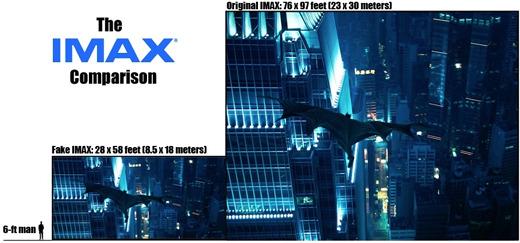
In 2000, there were only 205 IMAX theaters worldwide. Disney released Fantasia 2000 in 75 of these theaters between January and April 2000. These early IMAX screens often struggled to find features. A good percent were located in museums, exclusively screening documentaries. Any programming, even risky ventures, were welcomed.
The opening moments of Fantasia 2000 acknowledges its place as a follow-up to a legacy. Scenes from the original movie soar over the orchestra, refamiliarizing the audience. These floating sheets play brief snippets of the classic shorts while the musicians warm up. Memories are conjured and emotions are ignited. Nostalgia is a key role in setting the mood.
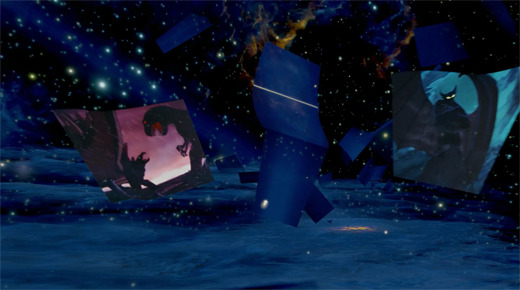
Stylistically, things are different. Gone are the shrouded musicians cloaked in darkness. Instead, things are bright, illuminated, and crisp. The music is no longer the primary subject; deprivation and mystery won’t benefit the film. The focus of Fantasia 2000 is the spectacle. Disney wants their orchestra seen and appreciated.
This time around, the majority of the music is performed by the Chicago Symphony Orchestra, and conducted by James Levine. The exceptions are The Sorcerer’s Apprentice, which uses the archival music from 1940, performed by an ad hoc ensemble of Los Angeles musicians, conducted by Leopold Stokowski. The other segment is Rhapsody in Blue, performed by London-based Philharmonia Orchestra, conducted by Bruce Broughton. Rhapsody in Blue was a late addition to the film; the original Fantasia 2000 performers could not be reassembled in time for its performance. They do perform Rhapsody in Blue on the film’s soundtrack.
The original film featured Deems Taylor, an esteemed music critic of the era, as the emcee. He was tasked with introducing each segment and providing background to each short. It gave the film an anchor and a voice. It gave the film a sense of authenticity, clueing in the audience to the curated secrets; what was onscreen, and why.
Fantasia 2000 lets their segments (mostly) speak for themselves. In lieu of an expert on classical music, a bevy of celebrities introduce each segment. Stars from stage and screen drop in, offering a variety of takes.

A few of these celebrities contribute in the film’s favor. Violinist Itzhak Perlman seems quite knowledgeable. As does music producer Quincy Jones. Actress Angela Lansbury takes her role seriously and with gravitas. But the others, not so much.
Actor James Earl Jones musters all his thespian might, but he has been tasked by the writers to do nothing but recite a flat joke. Magician duo Penn and Teller go on a long tangent about illusions that loses sight of their original point. Singer/actress Bette Midler has an odd, slightly insulting tone when she discusses segments cut from the final film. And comedian Steve Martin just ruins everything.
Martin delivers an unwelcome bit of schtick, feebly trying to play a violin at the film’s onset. The camera pans away from him, scanning the orchestra, desperate to focus attention elsewhere. You can feel the pain and torture of each musician, forced to sit in uncomfortable silence as Martin continues hamming things up off-camera.
It’s obvious, these celebrity introductions were done to attract audiences. Disney could put A-list names on posters and press releases, stirring interest. In execution, they do nothing in the film’s favor. It was a failed attempt to court a disinterested market, but more on that later.
The first segment of the film is Beethoven’s Fifth Symphony. Widely considered the most iconic and recognizable work in all classical music, there’s no better choice to begin the film. The four-note opening bar can be identified by people from all walks of life.

The segment features a bunch of abstract butterflies. Nothing more than two triangles each, they look more like origami than insects. The creatures swarm and swoop across a variety of vivaciously colored landscapes.

The opening is a parallel to the opening of the original Fantasia. The original used non-representative forms and shapes to convey emotion and feeling. Here, geometry and motion fulfill the same purpose. The difference being, instead of pure abstraction, it’s constructivist. They’re clearly supposed to be butterflies, just drawn in a very unique way.
The butterflies are trying to convey a narrative about a chase. Something exciting, something perilous, and something invigorating. Which undermines the animation style. Is it supposed to be abstract, or literal? The film can’t decide. It’s too underdeveloped to be a full-on story, but too overdeveloped to be ethereal. It’s confusing, but at least it’s short. If you can’t think of anything interesting to say, say it quickly and look nice doing it.
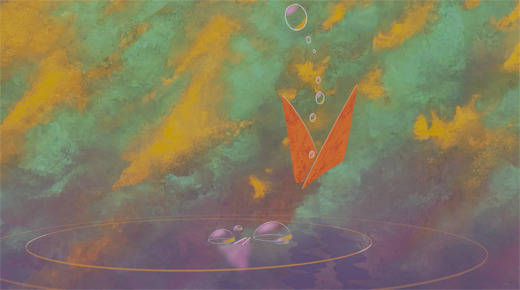
Segment two is Respighi’s Pines of Rome. It features a pod of whales, soaring majestically through the sea, breaching the surf in a majestic dance. Things get surreal when the whales take to the sky, breaching the clouds in the very same way. Throughout, a young whale is separated from his parents, trying to rejoin them.
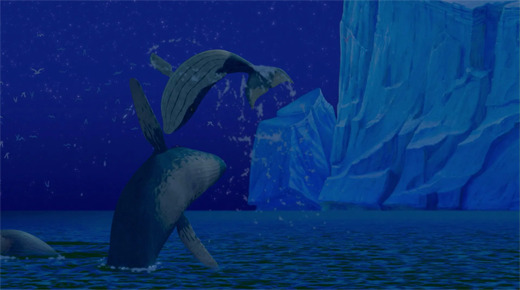
Again, the filmmakers have a strange idea about what Fantasia is and what a segment should be trying to accomplish. Just because visuals are matching the music, it doesn’t automatically make a fulfilled idea. Imagery and music are supposed to work in tandem to express a feeling. To convey an emotion. To share an idea. If it’s just a bunch of pretty pictures which happen to be set to music, it’s nothing more than a screensaver.
A segment can be a narrative, but that means it must have a definitive story with characters, struggles, and a resolution. Likewise, a segment can be a non-narrative, using forms to present nonliteral ideas and evocations. But don’t split the difference.
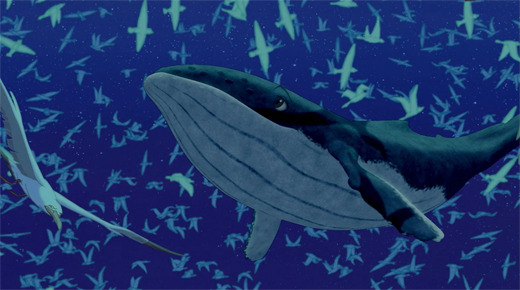
Nothing happening onscreen makes sense. Not in the ‘It’s experimental’ manner. Not in the ‘It’s open to interpretation’ manner. Not in the ‘It’s a dreamscape’ manner. But in the ‘I guess they’re over here doing this now, and I guess that’s unconnected from what was happening before’ manner.
Pines of Rome tries in vain to tell a story about a young whale not keeping in step with parents, somehow getting left behind. Along the way he somehow gets trapped in an iceberg, before somehow escaping. It’s not quite clear why any of this is happening, and it’s the second segment in a row that features a character being chased. There has to be something animators can put to fast-tempo music besides a chase scene.
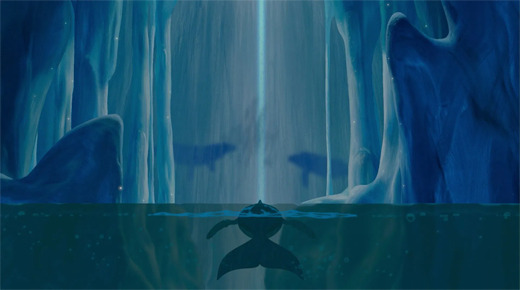
The aurora borealis is presented nicely, as are the star-draped sky, icebergs, and ocean water. If it were a ten minute segment of whales dancing in natural beauty, it would have been a wonderful segment. A baleen ballet. Instead, it’s a story about wanting to visit a star way off in the distance, getting to that star without any gravitational hindrances, then upon reaching that star, living life exactly as before the journey. Its a cryptic, baffling attempt at storytelling. But at least the whales look nice.
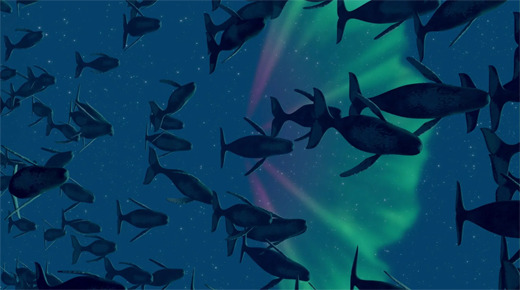
The third segment, George Gershwin’s Rhapsody in Blue, is a bit of a departure. The orchestral jazz piece stands in contrast to the other classical works. It’s from a different era and has been influenced by different styles. But the passionate instrumentation and symphonic panache makes it fit in beautifully among the classical music.
Inspired heavily by the artwork of Al Hirschfeld, Rhapsody in Blue paints a portrait of an idealized New York from the Jazz Age. Art deco style abounds. Progress and industry define the landscape. The city is alive with hustle and movement. Music and freedom of expression are key themes.
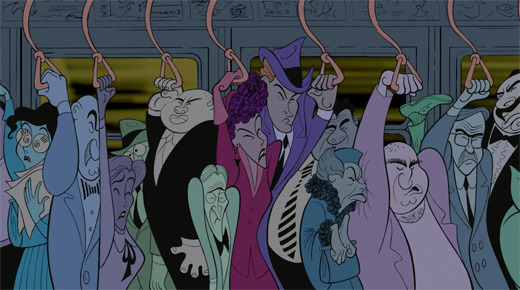
The segment presents four intersecting narratives. A construction worker resents his tedious job, wishing to pursue his dream of being a professional drummer. A wealthy man finds no joy in upper-class life, wanting to have fun and enjoy the simple things. An unemployed man with no money and no opportunities looks for any sort of break from his troubles. A young girl, ignored by her parents, is forced to participate in a gauntlet of classes she doesn’t care for.

Everything onscreen happens with great purpose. Every moment establishes mood, builds the environment, establishes character, or moves the stories. Every scene demonstrates the skills of the animators. Every scene has a clever joke. It’s impossible to be bored, and impossible to get lost.
The storylines bob and weave with great pace and great structure, never taking the limited scope for granted. We only focus on four characters, but we feel like it’s a city of five million. We see New York as a source of cold, sterile indifference. We also see it as a city of opportunity, passion, and fulfillment.

The four stories flow so naturally and smooth, never stepping on the others. All four flow well until their final culmination. All four fit succinctly and comfortably into a cartoon just under eight minutes. Rhapsody in Blue is without a doubt the highlight of Fantasia 2000.
Unfortunately, something has to follow. That misfortune goes to Shostakovich’s Piano Concerto No. 2. The fourth segment is an adaptation of the Hans Christian Andersen tale, The Steadfast Tin Soldier. The story involves a group of anthropomorphic toys. The titular tin soldier is damaged, having only leg. He falls in love with a porcelain ballerina, standing arabesque, whom he believes also has only one leg. But a malicious jack-in-the-box, jealous and scornful, interferes with their love.
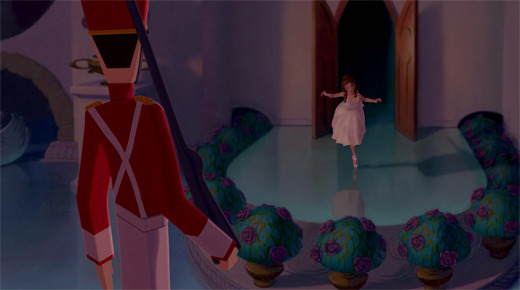
The story is fine. The segment is fine. The music is fine. There is nothing wholly wrong with this short. The idea of toys coming to life when no one’s looking is a staple of fantasy fiction. Andersen’s version of the fable was written in 1838.
But Disney produced this short a mere five years after Pixar Animation made the movie Toy Story. It was released two months after the sequel, Toy Story 2. Already bad luck, but Disney themselves distributed the films. They flooded the market themselves. Moviegoers had already seen and loved an entire movie with this concept. A short film based on antiquated material seems like a lesser version.
The animation is interesting. The three main characters are animated in CGI, but everything else is hand-drawn. Normally, the coarse turn-of-the-century CGI would be a strike against the film’s quality. Characters look blocky, the textures look flat, and the lighting looks off.
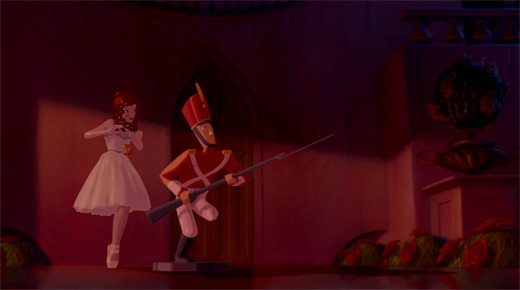
But in contrast against the detailed hand-drawn environment, the underwhelming CGI does the segment a small favor. The porcelain, tin, and wooden features of our main characters, in all their crudity, look emphasized. Because they look so garish, the eye is drawn to the foreground. Meanwhile, the rich details of the environment compensate for what’s underdeveloped.

Disney’s adaptation of The Steadfast Tin Soldier detours from Andersen’s original story. As is Disney’s modus operandi, the heroes get a happy ending at all costs. And there are costs. The entire story relies on a series of contrivances and coincidences. Some were present in the original Andersen tale. Some Disney provided. All will make eyes roll.
All together, the segment is hollow, feel-good treacle. If that’s not a deal-breaker, enjoy. For everyone else, it’s a segment that puts style ahead of substance.
Segment five is the strangest inclusion in the film. Set to the finale of Camille Saint-Saëns’s Carnival of the Animals, it’s a humorous escapade involving a flock of flamingoes. One of them bothers the rest with a yo-yo.
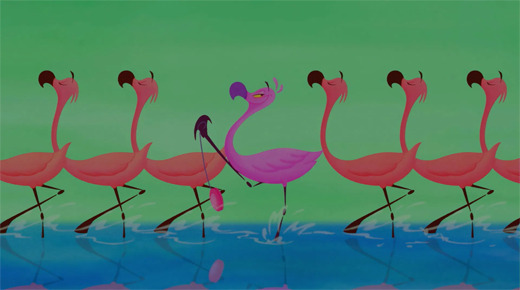
It’s clearly inspired by the original Fantasia’s Dance of the Hours sequence. Both segments feature a group of awkward animals performing an awkward ballet that turns chaotic. However, the flamingoes’ pratfalls are a far cry from the iconic dancing hippos and crocodiles.
Something about the procession seems inauthentic. The animators were trying too hard for the joke. They were desperate for laughs, and mugging for the audience was the easiest solution.

The segment is one brief idea that’s developed to its fullest capacity. The entire sequence is less than two minutes long, by far the shortest segment in either Fantasia film. It’s immediately forgettable.
Segment six is a reprise of Paul Dukas’s The Sorcerer’s Apprentice. A literal reprise. There’s no new performance by the symphony, and no new animation from Disney. It is literally the exact same segment from 1940. It’s even presented in fullscreen.
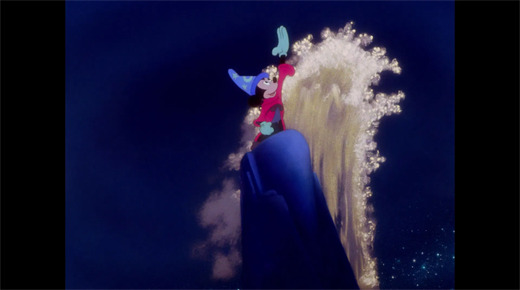
As mentioned, Fantasia was always intended to be an evolving project. New segments would be produced and swapped in, while old ones would find new audiences upon re-release. The Sorcerer’s Apprentice is the single most iconic element of Fantasia. Mickey Mouse in his wizard hat and the walking brooms are famous bits of Disney history. Their presence does more to stoke feelings of nostalgia and generate interest than a thousand celebrity hosts could.
Not including The Sorcerer’s Apprentice would be a mistake. It’s precisely what audiences want to see. Why deprive them of such a thing?
Sandwiching animation from the 1940s between cartoons from the 2000s provokes a sense of shock. Disney animation has an iconic look, but its easy to forget just how much that look evolved in sixty years’ time. The ink and paint of 40s-era Mickey Mouse looks sentimentally bygone next to the clean 00s-era computer graphics. Animation has come so far and made so much progress, leaving a long legacy in its wake.
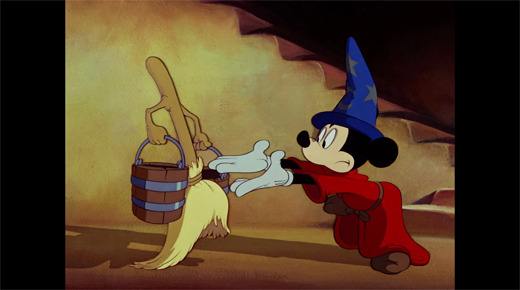
The Sorcerer’s Apprentice sketch ends just as it did in 1940. A silhouetted Mickey Mouse shakes the hand of conductor Leopold Stokowski. The film then transitions away from archival footage to an illuminated Mickey talking to conductor James Levine. Again, highlighting the branched legacy of both films, while acknowledging the advancements sixty years have brought.
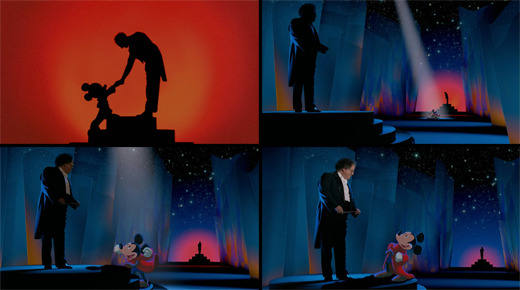
Mickey Mouse sets the stage for Donald Duck, star of the seventh segment. Set to the music of Edward Elgar’s Pomp and Circumstance, Donald presents a very loose retelling of the Biblical story of Noah’s Ark. Donald plays Noah’s put-upon lackey, tasked with counting and corralling the animals. In a comedy of errors, both Donald and Daisy Duck believe the other missed the boat and were consumed by the flood.
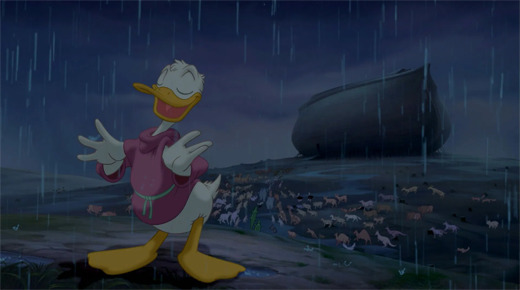
While Mickey Mouse has an air of dignity about him, even at the mercy of an army of enchanted brooms, Donald Duck has always been a broadly comedic character. And that’s precisely what he delivers in this segment. Donald is in over his head at every given point. Whether it’s trying to force a stubborn rhinoceros onto the boat, futilely trying to plug up leaks during a 40-day rainstorm, or stopping an incessant woodpecker, it’s all in service to the comedy. A golden bit of visual humor goes by quick, as Donald stares in confusion at a pair of non-humanoid ducks.
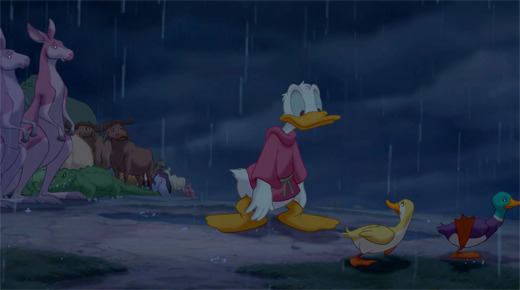
While the humor is great, it does illustrate the lack of sincerity and depth of someone like Donald Duck. You can’t have the angry, contentious Pekin treated like an affable punching bag for six minutes, then expect him to deliver pathos.
There are limits to what an audience wants and expects from certain characters. We barely associate Donald Duck with romance. We don’t associate him with grief. We definitely don’t associate him with Biblical epics. But that’s how Disney uses him, here. Whether he accomplishes his goals is subjective, but he was a dubious choice for such a project.
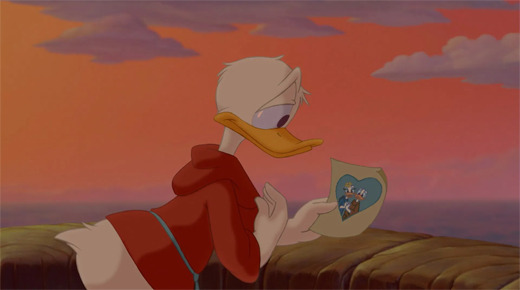
Using Pomp and Circumstance as the soundtrack is another odd decision. Fantasia’s mission was to avoid associated and stereotypical uses of classical pieces. It wanted the creative minds of animators to deliver what they saw and felt when listening to music. This is a noble approach for most classical pieces, a fool’s errand for others.
A work like Pomp and Circumstance is thoroughly ensconced in the public mind as the theme associated with graduations. It would take more than a Donald Duck cartoon to undo that connection. Whenever the animals walk in pair, one can’t help but think the buffalo just earned a bachelor’s degree. It was a noble effort on Disney’s part, but too ambitious with the tools they were using.
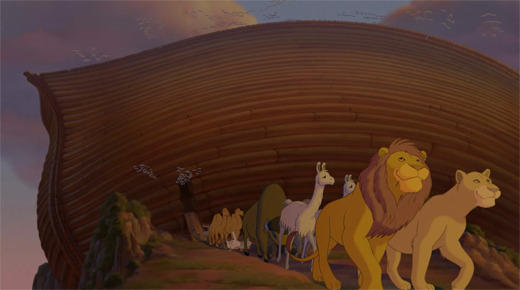
The eighth and final segment of Fantasia 2000 presents Igor Stravinsky’s The Firebird. Closing the show, it’s clear Disney felt this segment was the most perfect blend of music and animation. That it hit the highest heights, and would end the film with a definitive bang.
The segment depicts a benevolent forest spirit whose sylvan world is destroyed a volcanic eruption. The forest spirit is recognizable as warm, matronly, and and nurturing. She embodies the Mother Earth archetype, understood and sympathetic. But with her leafy, spectral appearance, eagle-like wings and angelic face, she’s an entity unto herself.
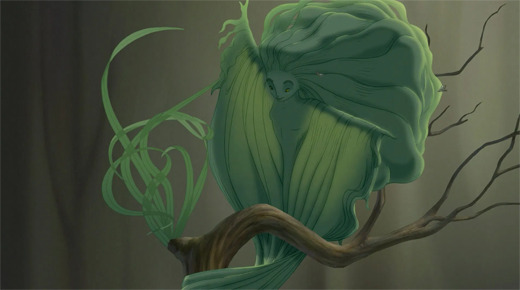
The way the short presents itself, it initially seems as though it’s a parable about pollution. The spirit is at the mercy of a temporarily unseen adversary, belching forth a cloud of smoke. Perhaps this was the original story at an early stage of development.
If this had been an environmental tale, it would be simple. It would be extremely one-dimensional and low stakes. Of course no one is going to root against a living forest as its felled by industrial machinery. Of course toxic waste and pollution are evil. What kind of moral for a story would that be?
Instead, it’s not a story about nature vs man. It’s a story of nature vs nature. Our hero is nature. Our villain is also nature. With all the beauty and life in the natural world, there are also powerful destructive forces.

The villain presents him self as an enormous hawk, composed of magma, belching forth a blast of fire. Our hero, in all her power, is dwarfed by the adversary. She cannot fight. She cannot hide. She can barely flee. She is at the mercy of a foe she had never considered.

What could have been a boilerplate story about conservation is now a deeply metaphoric fable. Where there is order, there is chaos pushing its way in. Where there is growth, there is loss. Where there is life, there is death.
A forest full of thriving life has been eradicated. A painstakingly curated ecosystem wiped out almost instantly. So much work, effort, love and beauty, all for naught. Everything is consumed by a torrent of molten rock, fire, and ash. It’s left the ground bare, gray, and empty. Things seem hopeless.

This isn’t a story about nature. This is a story using nature to tell a story. It’s a story about overcoming adversity. Through drive, determination, and tenacious endurance, the spirit overcomes. Things regrow. The forest is as verdant and lively as ever. That which does not kill, only makes stronger. After all, what is more nutrient rich and fertile than volcanic soil?
It’s a fable using nature as a visual representation of perseverance and hardships. Bad things will happen. Devastating things, even. But if the spirit is strong and willing, you can overcome. You can rebuild. You can start anew. Where there is life, there is death. But where there is life, there is also hope.
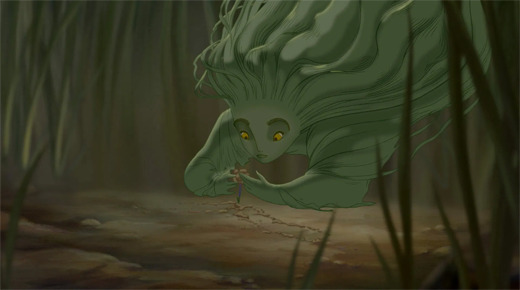
Visually it’s beautiful. Thematically, it’s powerful. Musically, it’s wonderful. It’s truly the best way to end the film.
Fantasia 2000 ends similar to how it began. Images again soar over the heads of the orchestra. Now, the classic stills from 1940 have been replaced with 2000′s original segments. Integrated into the Fantasia legacy, they now also belong to the ages. They are as every bit part of Fantasia’s family as their forbearers.

Fantasia 2000 had many things going against it. The odd release strategy targeting only specific screens was chief among them. It played in a very small number of theaters to a very limited audience. It wasn’t made for families in mind, but a far more discerning crowd. A brave decision, but haughtiness wouldn’t bring acknowledgment or acclaim.
Both Fantasias failed in similar ways, with slight differences in detail. Both were far too ambitious, artistic, and alienated the average moviegoer. Audiences expected certain things from Disney Animation, such as entertainment and mirth. Deeply artistic, experimental productions were not on the list.
While Fantasia has a level of acclaim today, most of it is nostalgia rather than honest appreciation. It’s largest section of champions aren’t Disney fans and families, but film scholars. The filmgoing public simply doesn’t care for classical music.

Fantasia 2000 may also have an opportunity to earn a retroactive appreciation. Maybe, but it will require every bit of piggybacking off the original’s reputation. Fantasia 2000 still stands in the shadows of the original movie. Its insistence on comedic frivolities, underdeveloped concepts, outdated CGI animation, and the forced inclusions of guest hosts make the film seem desperate. There are definite bright spots in the film, but they’re outnumbered. The film wanted to be hip and trendy and fashionable in its era, but it sacrificed longevity and honesty to achieve it. And it wasn’t even that hip, trendy or fashionable.
Fantasia was a failed experiment to make an ongoing, evolving film project, but Fantasia 2000 was not the only attempt to fulfill the idea. In the early 1990s, a film called “Musicana” was proposed as a Fantasia follow-up, but nothing came of it. At Disney parks, the Philharmagic show carries Fantasia’s legacy. Mickey Mouse, Donald Duck and other animated characters continue to bring classical music to life.

It’s an open secret that production was quietly started on a third Fantasia before Fantasia 2000′s release. This project would focus heavily on world music. But after the lackluster reception to Fantasia 2000, the project was abandoned before anything was officially announced. Several animated shorts from the early 2000s are survivors of the jettisoned project. Specifically, Destino (Mexico), The Little Matchgirl (Russia), Lorenzo (Argentina), and One by One (South Africa).

These four shorts appeared independently of the Fantasia brand, either attached to features or at festivals. Disney’s animators continue to make ambitious and thematic short animations set to music, clearly influenced by Fantasia, just not carrying the cursed name. The evidence dictates Fantasia is a better concept than an actual product.
Fantasia is an idea that’s been tried, tested, and unwanted by mass audiences. A film company, even one as big and influential as Disney, is beholden to the market. Film, music, and animation can carry thoughts, share ideas, convey feelings, and tell stories. But Fantasia 2000 just didn’t find receptive eyes and ears.
Beauty and the Beast Fantasia The Lion King Snow White and the Seven Dwarfs Cinderella Alice in Wonderland Sleeping Beauty Mulan The Little Mermaid Aladdin The Many Adventures of Winnie the Pooh Pinocchio The Jungle Book Robin Hood The Sword in the Stone Bambi The Hunchback of Notre Dame The Great Mouse Detective 101 Dalmatians The Three Caballeros Lady and the Tramp The Rescuers Down Under The Fox and the Hound Fantasia 2000 Peter Pan Dumbo Hercules The Black Cauldron Melody Time Oliver & Company Tarzan The Rescuers Pocahontas Saludos Amigos The Adventures of Ichabod and Mr. Toad The Aristocats Fun and Fancy Free Make Mine Music
#Fantasia 2000#Disney#Walt Disney Animation Studios#walt disney#disney studios#Disney Canon#Film Criticism#film analysis#movie review
4 notes
·
View notes
Note
Serbia? Or Montenegro? What are your opinions on their joint entries BTW? I think there were two?
Slow down lad, I can only do five videos on one post remember? 😂 But I can do three entries I like from Serbia, one entry I actually remember from Montenegro and I’ll tack the other two onto the end.
(She says, having thought there would be just five songs on this post because she forgot how to count to six apparently)
Anyways, songs, songs....
SERBIA
3) 2018- Sanja Ilic & Balkanika- “Nova Deca”
youtube
I can’t be the only one who thinks this sounds like a killer anime theme song right?
2) 2015- Bojana Stamenov- “Beauty Never Lies”
youtube
Who would’ve thought this mod would fall for a generic “I’m different and that’s good” club song?
1) 2007- Marija Serifovic- “Molitva”
youtube
LET’S GET DOWN TO BASICS! TO COMPLETE! THIS ASSSSSSK
Ahem, onto the one entry I remember from Montenegro...
MONTENEGRO
2014- Sergej Ćetković- “Moj Svijet”
youtube
Well, it’s their only entry to have ever qualified iirc, it must have some broader appeal.... And it worked on me so who knows ¯\_(ツ)_/¯
Anyways, song reviews.... gonna put this under the cut to stop this post from being a bastard and a half to scroll through 😅
Serbia & Montenegro 2004- Željko Joksimović & Ad Hoc Orchestra- “Lane moje”
youtube
This feels like one of those songs that’s clearly got a demographic and a target audience who stan the absolute Hell out of it... But it just doesn’t grab me in the same way. It’s a nice, relaxing song of course, the singing’s good considering this was the era where the singing was starting to become less and less in tune, but there isn’t much here that would make me come back to it any time soon after finishing this ask. Hell, I doubt I’ll remember the tune by the time I’m done reviewing the next song
Serbia & Montenegro 2005- No Name- “Zauvijek moja”
HEY GUESS WHO CAN’T FUCKING COUNT.
Anyways, this one started out promising. That intro had me hooked. And then the violins started and this turned into a generic desert-themed background music from a video game. Which isn’t a bad thing, but it does mean that I immediately forgot the tune as soon as it was over and I immediately put on the Snif City theme from Paper Mario. Which is a song I’d definitely recommend you go listen to.
Cheers for the ask! And cheers for reading if you got this far ;D
3 notes
·
View notes
Text
In the Whole Wide Train | Chapter 2
Pairing: Curtis Everett x Reader (Jo, OFC), slight Edgar x Reader
Warnings: Major spoilers for SNOWPIERCER, dystopian society and its countless problems, mentions of forced abortions, language, violence, deaths, slow burn, eventual smut
Synopsis: Having grown up in the Front Sections of the Snowpiercer, you venture down the train when a rare opportunity presents itself, but the excursion quickly changes flavor when you arrive in the Tail Section.
Author’s notes: So after a bit of tinkering with the outline, the entire series has been retitled In the Whole Wide Train, and going forward each chapter will have a title as well.
Taglist is also opening starting from this chapter. Please shoot me a note if you’d like to be tagged.
Series Masterlist | Read Chapter One - Doing Right
Chapter Two - Keeping Habits
Funny how sometimes the right thing could feel...so wrong.
You picked the two pieces of wood Timmy had scavenged from around the section and placed them on either side of Doris’ bandaged hand. The elderly woman let out a hiss of pain.
“Sorry Doris.”
Earlier at noon, when the guards came in with the protein blocks, they asked for a violinist. After some hesitation, the old couple that Tanya introduced to you walked up.
“Excuse me, sir. My wife and I played the violin in the Boston Symphony Orchestra. I was the first chair.”
“Do they usually pluck people up to the front like this?” You asked Edgar as you inched up towards the front of the protein block line. Ever since he heard about your Mason story, he’s taken quite an interest in you.
“Yeah, these bastards with their steak dinners and their string quartets think they own us.”
“We’ll be different when we get there.” Curtis said behind you.
You raised your eyebrows at Curtis. Progress. This is the first time they mentioned their plans of revolting in front of you. Even though it’s really an open secret in the Tail Section. Maybe the little run-in last night wasn’t all bad.
Curtis caught your look, “What?”
“Nothing. Just wondering how long it’s been since you washed your face.” You diverted the conversation with a slight dig.
“Look around, you’re the exception here.” Curtis fired back in a rare moment of levity, “And in a few more days you’re gonna look like this as well.”
“What, I’m gonna grow ten inches and sprout a full beard?”
“All kidding aside, Jo, water is scarce here, and soap even more so,” Curtis returned to his serious demeanor.
Edgar was quick to add on, “You really gotta kick the habit of washing your face every day.”
“Man, you two make it sound like a drug addiction.”
The three of you reach the front of the queue. You scooped up your block of squishy sustenance and started to walk back to your bunk, when suddenly a struggle broke out behind you--
Wham! One guard had knocked Doris to the ground with his rifle. While another guard ordered everyone to sit down.
“What the--” You wanted to go help Doris but a strong grip on the forearm held you in place. Your head snapped back to see Curtis sitting on the ground next to you.
“Sit down. Edgar you too.”
Edgar was not convinced, “You can’t just let them--”
Around the three of you, everyone else obeyed, not a single question asked. This almost seemed a natural occurrence.
Curtis tugged at your arm again, “Now’s not the time.“ Behind you a loud stomp and a shriek from the woman--the guard crushed her violin-playing hand. You jumped slightly at the noise.
But Curtis was right. And so, you sat.
As you gingerly tied the ad hoc splints around Doris’ broken hand, you wondered if the previous surveyors had ever witnessed such a thing, or if you were just unlucky.
---
Edgar whistled as he leaned against the door to the only bathroom in the Tail Section. A man walked up to him, wrestling a little boy with him. Edgar shook his head at the man. A few bunks down, Curtis watched the exchange while chewing on his protein block.
“Hey it’s our turn to wash now. Whoever’s in there should wait their turn like all of us!” The boy doesn’t seem so eager for his turn, Curtis thought.
“Hey, hey, hey! She’s sewing up Doris in there. Keep this up and the next person she sews up will be you! “
The door opened a slit and Jo popped her head out. The man gripped the boy with one hand, and reached to pull the door further open, but Edgar blocked him. The boy was still trying to get away.
“What do you think you’re doing?!”
Curtis tensed and took a few steps closer--he knew better than anyone how easily a small friction could turn into an all-out brawl here. But before he could reach the scene, Jo puts a hand on Edgar’s shoulder.
“It’s OK, I’m done anyways.”
Jo led Doris out from the dingy bathroom, the horrible gash on her nose now patched up. The man muttered something and walked in. Curtis shook his head, somewhat in relief. Edgar really needs to learn to take it down a notch sometimes.
He thought back to the incident earlier. Edgar was almost ready to fight the guard if he could. So hot blooded. Then there was Jo... Curtis didn’t know what to make of Jo yet. Could she be the “help” that the red letters inside the bullet casing promised? Or did she just happen to be exiled at this moment in time? But there’s something about her, something besides her medical experiences, and let’s call it her naiveté for lack of a better word, there’s something about her that made her stand out, made his thoughts keep returning to her.
“Please, Jo!” The excited chatter of children pulled Curtis from his pensive state. All the young kids, Timmy included, had cornered Jo and were asking her about life in the front sections.
Curtis stepped closer, interested to hear what Jo had to say.
“Did you like it in the front sections?”
“Oh, heavens no, that’s why I came to be with you!”
A girl, she must be only four or five, tugged at Jo’s sleeve, “What’s it like there?”
“Well, in the front sections everybody has their own room, and...”
“What’s a room?” Timmy asked.
“A room is...” Jo picked up Timmy and put him on her lap, “You know how we all live in this big section?” Timmy nodded.
“Well a room is a thousand time smaller, and you are the only one living in it.”
“That’s lonely.” Another kid said.
“That’s right. You wouldn’t be able to play with your friends, all...” Jo counted, “all eleven of you. And you will have to brush your teeth--”
“Noooo!”
“Scrub your hand--“
“Ewwwww!”
“Wash your face, every day!” Jo’s eyes found Curtis when she said that. Curtis couldn’t help but smile.
Wow, really? He mouthed.
Jo cocked her eyebrows. Her plump lips curved upward, as if to say “yes really”. Their eyes held for a moment before she returned her attention to the children.
“Curtis!” Curtis ripped his eyes from Jo and sought out the voice calling him. It was Edgar.
“Gilliam wants to see her.” Of course.
---
"He's just behind the curtains. We’re almost there.” Curtis said as he led you towards Gilliam’s quarters.
*At long last. *You fidgeted with the notebook concealed beneath your layers of clothing to make sure it wouldn’t fall out as you walk.
“So, who’s Gilliam?”
“He’s the one running things around here,” Edgar chimed in beside you, “But he’s grooming Curtis--”
“Edgar, enough.” Curtis said as he lifted up the curtains to let Jo through, “Stand watch, this won’t be long.”
“Aww I thought I would be able to come in—" Edgar whined a little but did as he was told.
The first thing that greeted you was the giant W seal on the wall once your eyes adjusted to the dim lighting. Even in the Tail Section of the train, Wilford must announce his complete and utter control over the Snowpiercer.
“Hello there,” A raspy British voice sounded from behind the shadows before Gilliam, his cheeks hollow, his hair disheveled, his eyes cloudy in his old age, “Come sit down.”
Gilliam pointed to a handful of what used to be pillows on the ground. You obliged.
“Curtis will you give us a second please?”
Curtis nodded, “Just call me when you need me.”
Gilliam waited until Curtis had walked well out of earshot before whispering to you, “So, that notebook hurt at all when you sit down?”
“Not one to beat around the bush, are you?“
Gilliam chuckled, “When you’re as old as I am...” He lifted his left arm, and you were shocked to see a steel hook in place of his hand. He tapped the hook on the upturned crate. “Let me see what you have so far.“
You pulled the notebook from under your clothes and opened it for Gilliam, “Need a light?“
“Oh, I can quite manage, thank you dear.”
Gilliam made small noises as he read your observations. Meanwhile, you took the time to look around the room again. Upon the wall was pieces of newspaper, parchment, notebook pages, broken pieces of what remained of the world before. He even had a couple of bronze statues scattered here and there, serving as book stops or clothes hangers. But your eyes kept coming back to Gilliam’s metal appendage. What happened there?
After a while Gilliam closed the notebook, “So when are you going to tell Curtis?”
“All in good time.” You weren’t exactly lying there.
“Now, forget what you were sent here for, and tell me. Do you think Curtis is up for what he must do?”
A quick look outside told you that Curtis had returned, and was standing with his back to you, engaged in some kind of discussion with Edgar. “Edgar thinks he’s the second coming. Well he’s not that, but I think he might surprise himself when the big moment comes.”
For a moment or two, Gilliam was lost in his own thought. Then suddenly, he called for Curtis, “Curtis will you join us? And bring Grey.”
As you scrambled to hide your notebook, Curtis walked in with another man in his early twenties, his eyes round and sparkling with an unidentifiable fire. This must be Grey.
“As I was saying, Jo you can come here any time to read what scraps of book I have.”
Message received. You picked up what looked like a ripped half of a book and told Grey you would return this later that same night, before leaving Gilliam and Curtis to their revolt planning.
Later that night, in the magical hour when the whole Tail section has fallen asleep, you finished scribbling in your notebook, and climbed down from your bunk and went into Gilliam’s quarters. Grey spotted you pretty much the moment you got out of bed, but he let you in without a word. Leaving you to wonder, does he ever talk at all? Gilliam was fast asleep, so you tip-toed to the giant W insignia on the wall, and slowly pushed it in on the right side--
The seal slowly spun to reveal a telephone. You reached out to pick it up, but your hand wavered mid-air.
Inhale. Exhale. You took a deep breath to steady yourself. This is it. You could hear your heart beating in your eardrums. It shouldn’t be this nerve-racking to you--it’s not like you haven’t made reports as a surveyor before, but this one, this goes straight to Wilford.
By the time you realized Gilliam had woken up, he had heard most of your report. You hung up the phone quietly and spun the seal back into place before turning to him.
“So, he wants to know how many young children there are.”
You nodded.
Gilliam sighed, “Well, I suppose we’ll find out why soon enough.”
You said good night to Gilliam and walked back. When you got to your bunk, you found a small clump of cloth sitting on top of a scrap of paper on your pillow.
The note said, “For your addiction.”
It would be really funny if someone gave you Kronole as a welcome gift, you mused as you picked up the cloth bundle and shook out its content--
A tiny piece of soap fell into your hand. It’s the thinnest, most fragile looking piece of soap you had ever seen. It’s virtually transparent. But at least you get you keep your habit for a while longer.
#Chris Evasn#chris evans x reader#chris evans fanfic#Curtis Everett Fanfic#Curtis Everett x Reader#Curtis Everett#Snowpiercer Fanfic#Snowpiercer#chris evans x you#Curtis Everett x you
42 notes
·
View notes
Note
Brio - “stop making empty promises!”
The first time Beth thinks about divorce, it’s several years in. They don’t have any kids yet, but the mortar of Dean helping with her mom’s medical bills is fresh, sticky and binds them to each other. He works and she manages their lives, preparing meals, running their errands, and helps Annie and Gregg and Sadie. Her life with Dean itches, and it blankets her like thick wool.
She always maintained straight A’s, despite working part-time and babysitting on the side. She volunteered with Key Club, was active in Student Council, even though as she grew older she no longer had enough time for orchestra. Despite all the hurdles growing up, she had hoped she would be the first in her family to graduate from college. She finished twenty credits at Wayne County with an impeccable GPA before her mother’s medical bills became too much. Her mom needed her, Annie needed her, and there was Dean. And now here they are.
At first, she thinks it’s a mean-spirited, passing thought. Except, it sits with her. With her mother dead, her father gone, all that she has left in the world is Annie, herself, and Dean. And Dean is sweet, goofy and he helped her laugh through the stifling fog of her mother’s illness. However, despite how stable it is, Beth knows that she doesn’t love him.
A few months later, she becomes pregnant for the first time. Beth is nervous, a complete wreck, and she is also filled with love and hope. She picks Dean. She picks growing her family. She decides to stay.
Over the years, the thought comes and goes. After three more children, after post-partum, and depression, and anxiety, and soul-crushing boredom - forget love. Beth doesn’t know if she could look at Dean with any warm and fuzzies again. After each birth, it rises, festering, but she doesn’t know if she’s strong enough. She thinks, if it gets really bad, worse than this tolerable bad, she’ll do it. She’ll divorce him. She promises it to herself.
It’s twenty years into her marriage when she discovers the infidelity. It devastating blow, but she’ll make do. Then, she pieces together the rest and she’s fifteen again, finding herself about to be swallowed whole by the precariousness of her class and financial standing. Worst of all, this time her kids are coming with her, too. It burns. Her thoughts alternate between survival and revenge. They swallow her up. She promises herself that now, or once she figures all of this out, the extent of his betrayal and how she will right it, she will divorce his lying, cheating ass. She promises herself that she will devour him, crush him into nothing after she’s finished.
In the midst of all of her pain when she’s certain there will never be sex or love or companionship in her life, enters a crime boss. The challenge of him sets her alight in a completely different way. He recognizes her and helps her to better understand herself.
One late night, over bourbon and scheming, he turns to her and asks, “Why you with him?”
The tenor is sexual as it always is with Rio. But, she sees that he’s curious if not confused. It’s funny because just several months ago wasn’t she sitting in a car with him, saying that there was no logical explanation for them to be together, and here he is questioning the existence of her high school sweetheart. The one he shot, but didn’t kill. And she’s still here, alone in a room with him.
She doesn’t have an answer for Rio.
---
More and more, Beth surprises her sister, her best friend, and especially her husband. She even surprises Rio. But most importantly she surprises herself. She realizes how much she has to learn about who she is and what she’s capable of. However, something that doesn’t surprise her is how quickly she can adapt to things that are unbearable. There’s been a complete upheaval of her life, but at the end of the day, she’s still married to Dean. She doesn’t know how to pull the trigger here. She tells herself it’s easier for the kids. She consoles herself that she’s absolutely going to do it, just not yet.
Time moves forward. The next year is a rollercoaster. What she has with Rio sours. Beth pulls a literal trigger and when she comes to she realizes it’s the last thing she could have ever wanted. She moves ghost-like through her life, and she can’t finish the paperwork for the divorce. Then, Rio reappears, is seemingly resurrected. Business is back to how it used to be. But, they will never be what they once were. She did this. This is absolutely her fault. The unbearability of her life with Dean pales to this pain. She is exhausted by surviving Rio’s wrath and all the thoughts she has of contrition.
Another night, there’s no bourbon, but it’s the two of them alone, and they’re talking business. Her phone lights up and she grits her teeth. Dean should know better than to call her when she’s working, and she thinks that he has such little regard for her time that he must have forgotten. She deliberates taking the call for a moment, and then she sends it to voicemail.
Rio’s watching her and a detached curiosity colors his face. “Why you still with him?”
It’s a good question. Dean has moved out and works at a hot tub store now. She can see how he talks about his coworker and knows that it’s over. Their custody schedule is solid and the kids have adjusted the new routine. Her excuse used to be that they didn’t have the money to go through with the divorce proceedings. But, now business is good. It’s been good since before Rio returned with his vengeance and they continue to be profitable business partners. She doesn’t have much emotion left for her husband, all of it siphoned to nurturing her children, supporting her loved ones, withstanding Rio’s punishing distance and cruel turns of phrase. She has nothing left for Dean but brittleness.
She bites her lip. “It’s easier.”
There’s a moment where Rio frowns at her. Her heart squeezes when she almost reads concern or disappointment, but the expression shifts and it’s clearly a sneer.
She takes a breath, and powers through the rest of the planning, with this indispensable person who hates her. Then she sends him home, and settles into her solitude, with her children fast asleep in their beds.
-
When it finally happens, it happens little by little. Divorce doesn’t happen in a day. They re-sign the papers. They hire attorneys. There’s no contest so it moves speedily enough. There’s one long session where they sit down together and with their lawyers and document a custody agreement, officially divide assets that were informally divided months ago. Afterward, Beth humors Dean, and they go out for a celebratory drink. He confirms what she suspected, and tells her that Gayle will be moving in with him at the end of her lease. It’s bittersweet.
Gayle is amazing. She will be an incredible ally in their co-parenting situation. Beth liked her from the first time they met. And Dean has grown but Beth can’t help but feel worried for Gayle and overall judgey of Dean and his hare-brained decisions. It’s not until she gets home, and relieves Annie from her babysitting duties, that she realizes what she’s also feeling is lonely. Even surrounded by these munchkins she loves, even with the thrill and success of her small-business career and criming, even with her sister’s ad hoc ways of showing support and Ruby’s ways of reminding her to care for herself. Right now, she’s just feeling it.
-
Eventually, all the paperwork is processed, and the court enters the judgment. Her attorney calls to confirm the good news. She’s free.
She doesn’t know how she feels, she doesn’t know that she feels anything. It’s finally happened. She calls out sick from the shop. She doesn’t get into it with Ruby and Annie, just says she’s coming down with something and spends the rest of the day in bed. Beth realizes that she feels awful, and it’s not for the loss of Dean or some glorification of their marriage. She feels mournful, devastated by the loss of who she was forced to be for years. She made herself small and pristine and performed a token version of herself as a person, a wife and a mother for so long. She can’t stop crying.
It’s quiet tears and then it swells and sobs rise up from her throat. Sometimes she pushes her hot, splotchy face to the pillows and is swallowed by her grief. She toddles around the house, eats a little bit, and collapses in her bed for a second day.
In the early evening, just after sunset, she startles, hearing the lock turn in the doors facing the backyard. Rio’s silhouette is in the doorway as he pauses and adjusts to the darkness in the bedroom. He must have used the hideaway key.
There’s nothing boss about her having been in bed crying for a second day. Her hair is matted, her skin is splotching, and she is still so sad. She remembers that he’s seen her worse. The memory makes her feel nauseous, and she hides her face, wrapping her arms around her knees.
Rio moves towards her and pulls back the covers, sliding into her bed. His arms wrap around her. She leans into the hollow of his throat and he murmurs, “You’re gonna be okay, Elizabeth.”
She smells his cologne and that scent that’s just him. She feels the cotton of his shirt against her sensitive skin, and the brush of his lips at her forehead. And the grief hurts, it really does, but she believes him.
32 notes
·
View notes
Text
Favourite things: Serbia
youtube
Lane Moje - Željko Joksimović and the Ad Hoc Orchestra
Serbia has an unusual history in Eurovision. Serbia was part of the seven state alliance that was Yugoslavia up until 1992. While Yugoslavia began sending Eurovision entrants from 1961, the entries mainly came from Croatia, Slovenia and Bosnia-Herzegovina. According to Wikipedia, only four of the Yugoslav songs came from Serbia; 1974, 1981, 1991 and 1992.
In 1992, the party came to an end and the states each decided to go their own way. Yugoslavia became FR Yugoslavia which was made up of Serbia-Montenegro and Kosovo. But due to UN sanctions regarding the Yugoslav wars at the time, FR Yugoslavia was banned from participating. They stayed away till 2003 when they tried to re-enter, but were declined by the EBU.
This was followed by the appearance of Serbia-Montenegro in the contest in 2004 and 2005; both songs made the final. But this alliance split as well in (tension rose famously at the 2006 national final where Montenegro jury did something quite unfriendly). In 2007, an independent Serbia took part, and they won first go. Serbia has since reached the final most years, missing out in 2009, 2013, and 2017.
Choosing a favourite song from all of the above is difficult, but also quite easy. Željko Joksimović has written five Eurovision entries; three for Serbia as well as one each for Montenegro and Bosnia-Herzegovina. This was his first entry to Eurovision and in my opinion the best. It begins quietly like a delicate warm wind on a summer day and then it builds with more sounds and instruments are introduced. The violin player introduces a cold chill to the song and the drums thunderclaps as the song becomes are melodic storm. It almost won.
4 notes
·
View notes
Text
Opinion | Brahms, the Berlin Philharmonic … and Me
On a Thursday in May, 101 musicians gathered on the stage of the Philharmonie in Berlin to rehearse the First Symphony by Johannes Brahms and then perform the work under the direction of Simon Rattle, the Berlin Philharmonic’s conductor. For Mr. Rattle, or Sir Simon, or his preferred Simon, this would be one of his final concerts at his home for the past 16 years before taking over at the London Symphony Orchestra. Same Day Payday Loans Online
Despite the imposing venue, those 101 musicians were amateurs all. They came from 30 countries, their ages ranging from 10 to 75. I was the elder bookend, one of six French hornists selected, and lending the event a special sweetness was the fact that I, like many others who play for sheer pleasure, chose not to pursue a professional career. Send Money, Pay Online or Set Up a Merchant Account - PayPal In fact, I played virtually not at all for 37 years, and returned to my first love only 15 years ago.
This was our route to Berlin: Having seen the event announced online by the Berlin Philharmonic at the start of the year, we auditioned by video for members of the orchestra. The ad hoc ensemble, known, cunningly, as the Be Phil Orchestra, offered a remarkable opportunity — to be a weeklong guest of one of the world’s great ensembles, attending its rehearsals, being coached by its musicians and performing under its music director.
Of the 1,900 avocational instrumentalists who expressed interest in participating, 1,000 were auditioned online, and the Berlin Philharmonic musicians then selected the 101. The occasion was a reprise of similar events that the Philharmonic hosted twice before, though not in recent years. Whether the tradition will continue after Mr. Rattle relinquishes his post of music director and relocates to London — his successor is the Russian Kirill Petrenko — is at present unknown.
1 note
·
View note